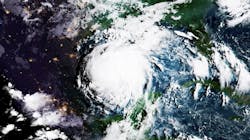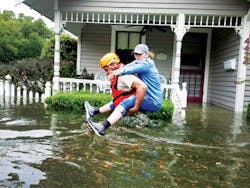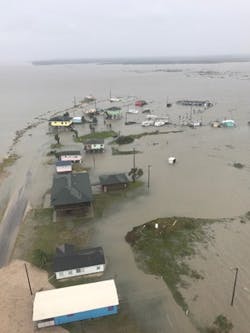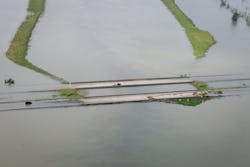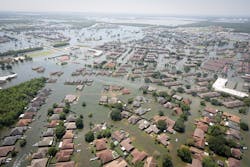Hounded by Harvey
A week before Labor Day, the people of Houston were not thinking about cookouts, beach parties or a day of relaxation. Hurricane Harvey, a Category 4 hurricane, came barreling toward the Texas coast, made landfall Aug. 25, and threw a wrench into plans for a day off. It lashed coastal communities with high winds and blanketed much of the city in water. According to National Weather Service records, Harvey became the second wettest tropical storm to hit the U.S. with 51.88 in. of rainfall—just 0.12 in. shy of the wettest storm ever (52 in. during Hurricane Hiki in 1950).
Levees overtopped. Rivers swelled beyond their banks. Dams were purposely opened to relieve their water basins. The National Guard mounted rescue efforts throughout Texas and Louisiana to save those stranded by the storm. Shelters were evacuated.
Water and wastewater treatment professionals did their best to battle against the rising flood to ensure water and sewer services were not interrupted. Some held strong, but others took a beating.
The Texas National Guard offered rescue help near Houston; Credit: 1Lt. Zachary West, 100th MPAD, Texas National Guard, http://bit.ly/2xpFCjG
Beaumont, Texas
As Harvey approached the coast, the National Weather Service declared it a Category 5 hurricane, a distinction for tropical cyclones with wind speeds in excess of 157 mph. But as it hit Houston, it made a turn to the northeast where it buried Beaumont, Texas, in more than 47 in. of rain. According to a PBS Newshour report, the Beaumont Water Treatment Plant lost power at its main and secondary pump stations. The plant was flooded and inoperable, and authorities were forced to shut it down, leaving 118,000 residents without water. Beaumont Public Works Director Joe Majdalani handles the water utilities for the city, but due to the increased workload in getting the plant operational following the storm, he was unavailable at press time.
According to the Beaumont city website, the facilites consist of a surface water treatment plant—rated at 40 million gal per day (mgd)—and a groundwater system. A majority of the plant’s water comes from the nearby Neches River, which swelled and flooded following the torrential rain from Harvey. The groundwater system consists of three deep wells, four booster pumps and two 5 million gal storage tanks, making for a 17 mgd facility.
Brian Archibald, a rescue specialist assigned to the South Carolina Helicopter Aquatic Rescue Team Delta in McEntire Join National Guard Base, S.C., points to a resident needing help. Credit: Staff Sgt. Daniel J. Martinez, Air National Guard, http://bit.ly/2xRG3ow
According to a Sept. 4 report from PBS Newshour, Beaumont Police Chief James Singletary said the city was getting water back to its residents, albeit slowly.
“It would be a totally different interview to tell you how [we restored water functionality]. But we had some private industries and working with our water folks and getting it restored,” Singletary told PBS. “So that in itself is an amazing story. But we’re slowly but surely getting the water restored. It’s going to be a while before we are going to lift the boil water notice right now.”
Some residents without water resorted to capturing muddy water from rivers and overflows to fill their toilet tanks so they could flush, according to a report from NPR; hotels used water from their pools for flushing. The Baptist Beaumont Hospital evacuated patients to nearby hospitals by ambulance and helicopter. While hospital spokesperson Mary Poole told NPR it was prepared with the necessary medical supplies and equipment, it had not planned for a loss of water, which she said was “a game changer,” for the facility’s preparations.
The National Guard provided helicopters for hoist rescues. Credit: Staff Sgt. Daniel J. Martinez, U.S. Air National Guard, http://bit.ly/2xQXvJG
Weathering the Storm
While the situation in Beaumont was dire and still in recovery mode by mid-September, some plants in the Houston area were not as adversely affected, despite more than 40 in. of rainfall. Nick Cook, water treatment plant supervisor of Deer Park Water Treatment Plant in southeast Houston, said Hurricane Ike gave operators the experience that prepared them to deal with Harvey. Employees boarded up windows, but otherwise made few major preparations.
“Our control building is in a two-story building. Even though we weren’t expecting winds, because we were going to have people here 24/7, we went ahead and boarded up our windows just to make sure the operators here had protection,” Cook said. Three elevated storage tanks feed Deer Park, he added, so in the days leading up to Harvey’s landfall, employees filled up those tanks in case of pump failure to provide pressure to the system.
General Joseph L. Lengyel, chief of the National Guard Bureau, receives a briefing.
Cook said the water plant lost power a couple of times during the storm, but the generator the facility replaced after Hurricane Ike kept the plant’s pumps running continuously. There was no loss of service, which he attributed to storm water drainage projects in addition to the cleaning and maintenance of those lines the week prior to the storm.
“Over the past several years, the city had done a lot for drainage, so even though I believe Deer Park received 46 in. of rain, drainage was really good where it was staying off of our pumps,” Cook said. “That aspect that has nothing to do with water treatment was also beneficial. That’s a testament to the other crews in the city and the foresight for drainage and drain control.”
During Hurricane Harvey, 51.88 in. of rain fell. Credit: Staff Sgt. Daniel J. Martinez, U.S. Air National Guard, http://bit.ly/2w9ZhRE
The storm only took out one valve that needed to be replaced, and by Sept. 8—two weeks after the storm hit—it was delivered to the plant. Similarly, Timothy Samford, water supervisor for the City of Texas City, Texas, said water infiltrated into some of his plant’s reducing stations that are kept in a vault below ground level.
“The sump pumps were overwhelmed and filled up those vaults,” Samford said. “We pumped everything out and then we’re going to replace electronics that are within that, the controls for that station.”
Despite those stations being overwhelmed, Samford said there was enough redundancy in the system that the plant was able to maintain pressure without issue.
Credit: Texas National Guard, http://bit.ly/2hl1Hqs
Building a Response
Responding to flooding, hurricanes or other disasters starts long before a storm is categorized. Joe Swiezbin, director of technology for Pall Water, said creating a comprehensive plan is crucial to getting a water or wastewater plant back to full capacity after a disaster.
Water treatment plant operators first should identify an alternate water source in the event the primary source is not accessible during the storm. Having an alternative is not always a complete solution, however, as in the case of Beaumont, both the primary and secondary sources were affected by Harvey. Swiezbin said reuse applications are a possibility for alternative water sources in an emergency.
Secondly, operators should also assess any system vulnerabilities and create an action plan for when disaster strikes.
“And the third part is what happens when something finally does occur,” Swiezbin said, “examine water treatment options that can be rapidly deployed to get to the site; you can easily install these and your water quality requirements are met.”
He said these emergency contingencies should be tested before they are actually needed. By familiarizing themselves with the equipment and technology ahead of time, operators will be more comfortable with using those systems in emergency situations.
Credit: Staff Sgt. Daniel J. Martinez, U.S. Air National Guard, http://bit.ly/2wJvVcd
Breadth & Scale
For research organizations such as Bluefield Research, Houston is a touchstone for water and wastewater infrastructure issues in the coming months, much like Flint, Mich., was a touchstone for water infrastructure in 2015. Erin Bonney Casey, research director for Bluefield Research, studied the magnitude of damage to pipe, infrastructure and water quality from Hurricane Harvey following the storm. She said Houston is an interesting case because of its growth and documented storm water overflow problems.
“The first thing you’re always looking at is the impacts of drinking water supply,” Bonney Casey said. “With those kinds of sewer overflows and the flooding of other chemical facilities and things, the water down there is going to be contaminated with sewage as well as trace amounts of chemicals and things.”
In the short term, power outages will affect pumps and slow down cleanup where water needs to be pumped out, she said. And in the long term, flooded pumps need to be repaired or replaced if they no longer are serviceable for their jobs.
The National Guard provided relief efforts to Harvey-affected areas, many of which were submerged in several feet of water. Many agencies and states assisted in relief efforts. Credit: 1Lt. Zachary West, 100th MPAD, Texas National Guard, http://bit.ly/2wJh8OQ
She said one of the gravest concerns for Houston in the coming months will be the long-term effects of those water quality issues. With sewer overflows and chemical plant flooding, aquifers are likely to be contaminated by infiltration. Those with private wells will need to get water tested just as municipal operators will have to pay close attention to their pollutant levels.
As the storm’s damages are assessed, the cost of repair and replacement will compete against other federal dollars, which could also lead to increased water and sewer rates to fund infrastructure improvements.
Credit: Staff Sgt. Daniel J. Martinez, U.S. Air National Guard, http://bit.ly/2fkkOnO
Financing a Recovery
Texas Gov. Greg Abbott called for the creation of Rebuild Texas, a commission tasked with creating and executing a plan to rebuild Texas following Hurricane Harvey’s disaster. As of Sept. 10, it has received donations for disaster recovery in excess of $40 million.
According to that commission, the Federal Emergency Management Agency (FEMA) has set aside $181 million for reimbursement for emergency response and debris removal expenses for local and state agencies. There also is $30 million in grant funding available for those agencies to hire temporary workers to aid in recovery efforts.
FEMA also earmarked $1.09 billion in federal dollars for Texans’ personal recovery. Of that pool, FEMA had already approved $333 million in grants for eligible individuals and families—more than 735,000 applications were received—for home repairs, replacement, and housing and rental assistance.
Photo courtesy of Aby Varghese.
Count on Community
While rioting and looting are focal points of many news stories during the chaos of a major storm or disaster, communities often are more connected. Following Hurricane Harvey’s landfall in Houston, wastewater professionals rose to the occasion and helped their neighbors.
Having survived Hurricane Ike in 2008 when he first moved to Houston, Aby Varghese, business development manager for inlet works for Ovivo, said he and his family were comfortable with keeping shelter in their home to ride out Hurricane Harvey at the end of August. Out of the storm’s direct path in Sugar Land, Texas, Varghese said force winds were reduced. Rain, however, became an issue as the Brazos River nearly overflowed and a local creek overtopped its levee.
“The water came up to the driveway, but the streets were all full. It was like 2 to 3 ft of wading water,” Varghese said, noting his home was spared but others were not so lucky. Finding relief and ways to pay for the flooding will be a major issue for homeowners, he added. “Many of these homes—I’d say 95% of people—don’t have flood insurance because … it’s not required.”
Like most companies in Houston leading up to Harvey’s landfall, Ovivo closed its doors. Much like the Ovivo office in Nassau Bay, south of Houston, took minimal damages, Hobas Pipe USA, located just west of George Bush International Airport, north of Houston, also was spared. According to a press release from Hobas Pipe USA, its facilities were shut down as a result of the storm event “due to transportation issues that prevented employees from getting to work and prevented raw material deliveries.” Pipe manufacturing resumed on a limited basis as materials delivery was still limited by mid-September.
With offices closed, communities rallied. Varghese helped neighbors tear out damaged flooring and soggy carpeting. A volunteer organization shared cleaning supplies and equipment, and families made food for each other.
“The community just voluntarily came out of their homes and asked ‘How can we help you?’ because this was over Labor Day weekend,” Varghese said, “so people had time and people had whatever they could and they were helping out. Neighbors were helping each other.”
Varghese’s coworker, Jim Impero, senior engineering specialist for Ovivo, used his boat to help a family in his neighborhood get off their roof. Varghese said he gave them shelter at his home and food after the ordeal.
It took about one week before businesses were back open—but still recovering—and Varghese returned to work. After catching up, he said he will be reaching out to local contacts about the damages incurred from Harvey to assess how he and Ovivo can respond to community needs.
